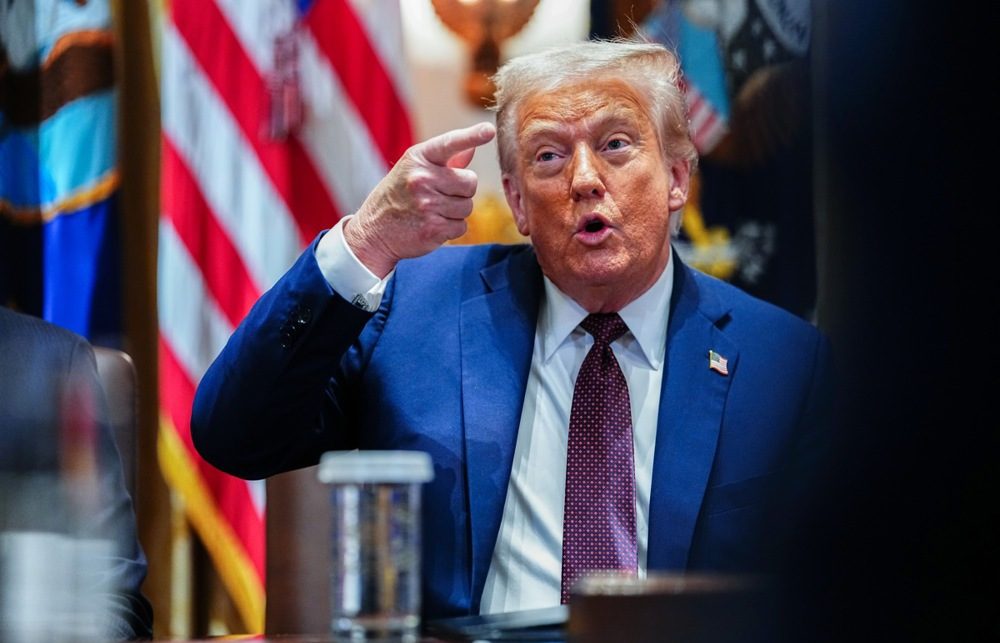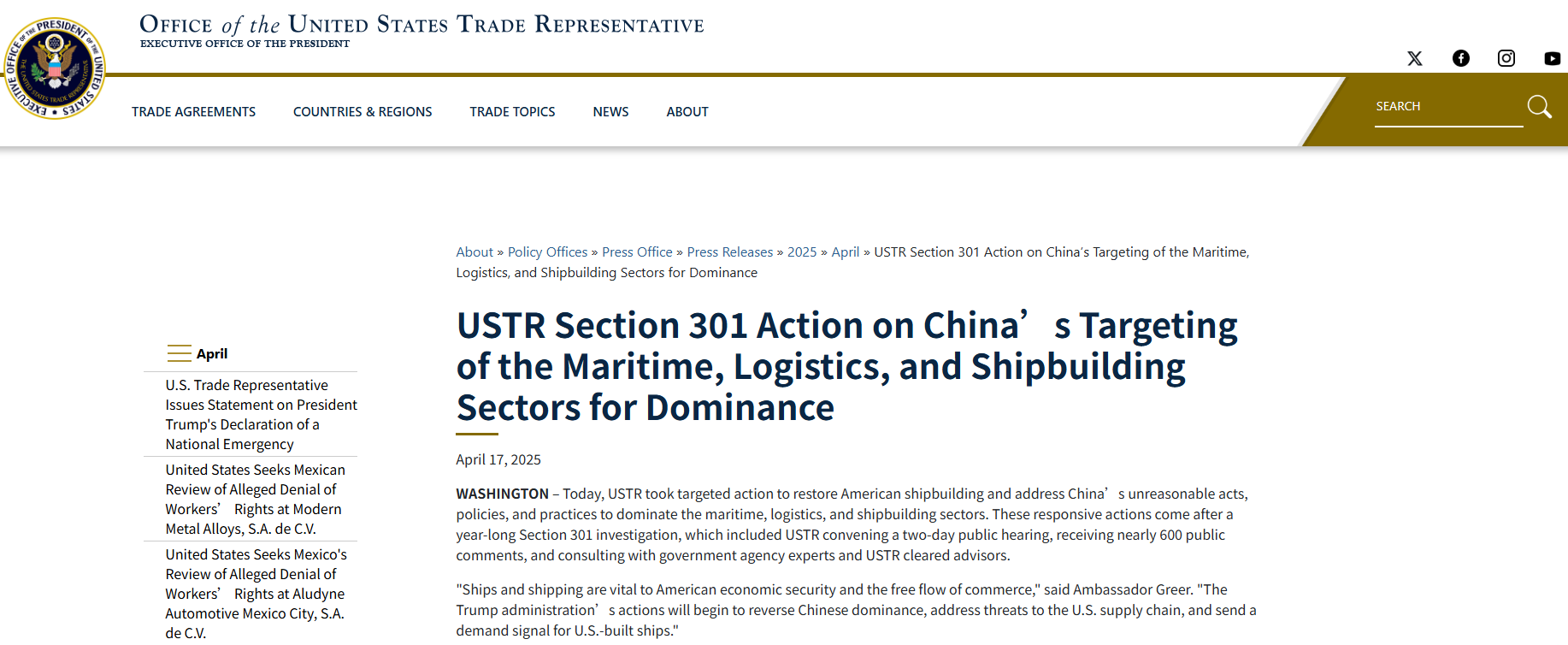摩根:连美国人自己都说,特朗普已成“关税恐怖分子”
【文/东方军事专栏作者 摩根】
这一周从混乱开始。美国总统唐纳德·特朗普宣布对所有中国进口商品征收100%的关税,令全球市场震惊。他指责北京采取了“极具敌意”的行动,因为中国限制了对美国工业至关重要的稀土材料出口。
这一举动看起来像是一种报复——一位长期痴迷于关税的总统的本能反击。市场立刻作出反应,道琼斯指数暴跌,仅一天就蒸发了近2万亿美元的市值。投资者担心,一场全面贸易战即将卷土重来。
不到24小时,特朗普就放软了口气。他在“真理社交”(Truth Social)上写道:“别担心中国,一切都会好的!中国不想陷入萧条,我也一样。”这与他先前的强硬言辞形成鲜明对比——从展示力量的表演,变成了自己制造的不确定感。

特朗普 资料图
以不变应万变
当华盛顿的言辞变得越来越激烈时,北京却保持了惊人的冷静。中国商务部发表简短声明,警告称:“动辄以高额关税进行威胁,不是与中方相处的正确之道”,并重申,关于贸易战“中国不愿打,但也不怕打”。
此后,北京几乎保持沉默——没有激烈的演讲,也没有戏剧性的报复。即便是在网络上,最初的民族情绪爆发之后,舆论也很快平息。整个中国媒体的基调可以用一句老话来概括:
“以不变应万变”——以稳定应对万变。
这句话精准地概括了当下中国的心态:克制、耐心,以及对局势最终稳定的信心。
特朗普的新一轮关税行动,是多年积累的故事的延续。2025年他重返白宫时,市场早已预料到结果——关税。上任最初几小时内,特朗普就重新点燃了其第一任期中定义性的经济民族主义——只是这一次,规模更大,目标更广。
在2020年的“第一阶段协议”之后,中美贸易战似乎有所降温。关税仍在,但升级停止。拜登总统任内语气变得温和,然而竞争却更深入。拜登保留了特朗普的大部分关税,同时将重心转向产业政策与联盟合作——推出《芯片与科学法案》《通胀削减法案》,并加强与欧洲、日本的协调。
中国则加倍推进自主化进程——扩大半导体项目、电动汽车制造以及可再生能源供应链。从中国的角度看,正是特朗普在其第一任期迫使中国完成了这一转型。早在2018年特朗普最初对中国发起关税和产品限制措施时,中国就清楚地认识到全球供应链在美国压力面前的脆弱性。此后近十年间,中国持续推动全面的自给自足战略——从芯片、电池到农业与航运——确保在2025年比以往任何时候都更有能力应对贸易战。北京从那次冲击中吸取了教训:要夯实国内实力,让未来的贸易战再无法撼动经济。因此,中国网友戏称他为“川建国”——意为“建设中国的特朗普”。
2025年4月,第一次激烈的正面对抗爆发。特朗普发起了所谓的“对等关税战”,短短几天内,中美双方进入疯狂的你来我往,关税水平飙升至历史高位,美股应声暴跌。当全球许多国家屈服于美国压力时,中国的坚定立场赢得了包括巴西、印度在内的全球南方国家的掌声。一幅题为《就不跪》的中国漫画在网络上走红,激起强烈的爱国情绪。经过从日内瓦、伦敦到斯德哥尔摩、马德里的多轮紧张谈判,双方都呼吁冷静。
从休战到升级
市场一度认为休战到来,但随后而来的沉默,其实只是新的倒计时。
到8月下旬,华盛顿扩大了针对中国科技与航运企业的出口管制,指控它们帮助规避半导体出口限制并支持“军民两用”供应链。不久后,特朗普的顾问团队提出禁止中国民航飞机飞越美国领空的构想,并获得总统公开支持。在北京,这些举动被视为赤裸裸的挑衅——而中国的回应既低调又精准。
到9月中旬,中国悄然暂停了新的美国大豆采购,并称此举为“市场调整”。事实上,这是首个有分寸的反制行动。期货价格迅速下跌,美国中西部的仓储设施开始爆满。华盛顿很快明白了这一政治信号:通过打击农业——特朗普选举基本盘的支柱产业——北京表明自己可以精准还击,而无需升级对抗。
几周后,中国港口管理部门开始审查与美国有关的航运公司的通关手续,以“技术原因”延迟多批货物放行。与此同时,根据美国贸易代表办公室(USTR)在4月17日发布的《301调查报告》,美国宣布将从10月14日起,对由中国公司拥有或运营、悬挂中国国旗或在中国建造的船舶征收额外的港口服务费,理由是“中国在航运、物流与造船业中的不公平竞争”。

美国对中国海事、物流和造船业发起“301调查”
从大豆到航运再到航空——每一步摩擦都加深了不信任,撕裂了脆弱的平衡,也为10月的关税冲击埋下了伏笔。
倒计时在2025年10月10日达到高潮。特朗普宣布要对所有中国进口商品征收全面100%关税,计划于11月1日生效。这项新措施不仅涵盖稀土和战略矿产,还包括汽车、电子产品、绿色技术组件和医疗设备——几乎覆盖了双边贸易的全部范围。
特朗普将此描述为针对中国“经济侵略”的“防御性举措”,指责北京把稀土出口管制武器化,而这些材料对美国的国防和工业至关重要。
北京的回应克制但坚定。中国商务部的声明指出:“动辄以高额关税进行威胁,不是与中方相处的正确之道”,并补充道,如果美国“执意走错路”,中国将“采取坚决措施维护自身的合法权益”。
市场再次动荡。欧洲主要股指下滑近1%,而比特币在暴跌后因北京选择不报复而反弹。目前,中国选择了冷静而非对抗——相信随着时间推移,经济规律终将让局势回归有利于自己的一方。
“关税恐怖分子”
唐纳德·特朗普的第二任期始终被一个关键词定义——升级。正如美国评论员所说,他已成为一名“关税恐怖分子”:利用经济破坏的威胁,不是为了谈判,而是为了表演。
自连任以来,特朗普把关税变成了既是武器又是舞台的工具——通过贸易来压制中国。这迎合了他的基本盘,但在这场表演背后隐藏着深刻的缺陷:美国已经失去了支撑真正贸易战的工业基础。
这种失衡在稀土领域体现得最为明显——它是现代国防、能源与科技的支柱。中国目前控制着全球70%至80%的稀土精炼能力,这得益于自改革开放总设计师提出“中东有石油,中国有稀土”以来数十年的国家投资。相比之下,美国既没有足够的设施,也缺乏与中国竞争的价格优势。其唯一重要的矿山——加州的山口矿(Mountain Pass)——仍将大部分矿石运往中国加工。即便投入数十亿美元补贴,要重建完整的稀土产业体系也需要多年,而政治意愿显然并不存在。
因此,特朗普的关税揭示了一个根本矛盾:他试图惩罚的,正是美国在军事和科技领域高度依赖的国家。这是一场没有筹码的贸易战。
当特朗普的威胁声在全球市场回荡时,中国依然稳如磐石。政府的沉默不是软弱,而是自信——表明北京明白自己完全可以等待。经济民族主义或许能在华盛顿赢得掌声,但中国的信息十分明确:
“以不变应万变”。
1 2 下一页 余下全文Trump the Tariff Terrorist
The week began with chaos. President Donald Trump shocked global markets by announcing a 100% tariff on all Chinese imports, accusing Beijing of “very hostile” actions after China restricted exports of rare-earth materials vital to U.S. industry.
The move looked like revenge — a reflexive strike from a president long obsessed with tariffs. Markets instantly revolted. The Dow Jones plunged, wiping nearly $2 trillion from U.S. value in a day. Investors feared the return of a full-scale trade war.
Within 24 hours, Trump softened his tone. On Truth Social, he wrote:
“Don’t worry about China, it will all be fine! China doesn’t want Depression, and neither do I.”
It was a sharp contrast to his earlier rhetoric — a performance of strength giving way to self-inflicted uncertainty.
While Washington’s language grew volatile, Beijing stayed remarkably calm. The Ministry of Commerce issued a brief statement through Xinhua, warning that “wilful threats of high tariffs are not the right way to get along with China,” and repeating that China “does not want a trade war, but is not afraid of one.”
After that, Beijing said little. No fiery speeches, no dramatic retaliations. Even online, public sentiment settled quickly after an initial burst of nationalist emotion. The tone across Chinese media could be summed up by an old saying —
“以不变应万变” — Stay steady to navigate all changes.
That phrase captures China’s current mindset with precision: restraint, patience, and confidence that volatility will pass.
Trump’s new tariff campaign is the continuation of a story years in the making. When he returned to the White House in 2025, markets already knew what to expect: tariffs. From his first hours back in office, Trump revived the same economic nationalism that defined his earlier term — only this time, the scale was larger and the targets broader.
After the 2020 “Phase One” deal, the U.S.–China trade war appeared to cool. Tariffs remained, but escalation stopped. Under President Joe Biden, the tone softened even as rivalry deepened. Biden kept most of Trump’s tariffs while shifting toward industrial policy and alliances — the CHIPS and Science Act, the Inflation Reduction Act, and closer coordination with Europe and Japan.
China, in turn, doubled down on self-reliance — expanding semiconductor programs, electric-vehicle manufacturing, and renewable-energy supply chains. From the Chinese perspective, it was Trump himself who forced this transformation during his first term, when his initial tariffs in 2018 exposed how vulnerable global supply chains were to U.S. pressure. Since then, China has spent nearly a decade building a comprehensive strategy of self-sufficiency — from chips and batteries to agriculture and shipping — ensuring that in 2025 it is far better prepared for trade wars than it was before. Beijing took that shock as a lesson: build domestic strength so that future tariffs could no longer shake the economy. That’s why Chinese netizens jokingly call him “Chuan Jianguo” (川建国) — literally, “Trump, the Nation Builder.”
The first major showdown came in April 2025, when Trump launched what he called a “reciprocal tariff” war against the world. Within days, China and the United States were locked in an aggressive tit-for-tat that sent tariff levels soaring to record highs and knocked U.S. stocks into a tailspin. While many countries bowed to U.S. pressure, China’s firm stance drew applause across the Global South — from Brazil to India — and even inspired a viral cartoon titled “We Will Not Kneel.” After tense negotiations from Geneva to London and Stockholm, both sides called for calm. For a brief moment, markets believed a truce had arrived. But the silence that followed was only a countdown.
The calm that followed April’s “reciprocal tariff” clash did not last long. By late August, Washington had expanded its export controls on Chinese technology and shipping firms, accusing them of helping to evade semiconductor restrictions and support dual-use logistics networks. Soon after, Trump’s advisers floated the idea of banning Chinese civilian aircraft from U.S. airspace, a proposal the president publicly endorsed. In Beijing, those moves were seen as deliberate provocations — and the response was subtle but strategic.
By mid-September, China quietly halted new purchases of American soybeans, describing the suspension as a “market adjustment.” It was, in effect, the first measured act of retaliation. Futures fell sharply, storage facilities in the Midwest began to fill, and Washington immediately recognized the political signal. By targeting agriculture — a cornerstone of Trump’s electoral base — Beijing demonstrated that it could respond with precision, not escalation.
Within weeks, Chinese port authorities also began reviewing access for U.S.-affiliated shipping companies, delaying several clearances on “technical grounds.” Meanwhile, according to the Section 301 investigation released by the U.S. Trade Representative on April 17, Washington announced that from October 14 it would impose an additional port-service fee on vessels owned or operated by Chinese companies, Chinese-flagged ships, and vessels built in China, citing unfair competition in maritime, logistics, and shipbuilding.
From soybeans to shipping to skies, each new friction deepened mistrust and tested the fragile calm — setting the stage for October’s tariff shock.
The countdown reached its climax on October 10 2025, when Trump announced a sweeping 100% tariff on all Chinese imports, set to take effect by November 1. The new measures covered not only rare earths and strategic minerals but also automobiles, electronics, green-technology components, and medical equipment — virtually the full range of bilateral trade.
Trump framed it as a “defensive move” against China’s “economic aggression,” accusing Beijing of weaponizing export controls on rare-earth materials critical to U.S. defense and industry.
Beijing’s message was measured but firm. Through Xinhua, the Ministry of Commerce declared that “wilful threats of high tariffs are not the right way to get along with China,” adding that if the U.S. insisted on “going the wrong way,” China would “take resolute measures to protect its legitimate interests.”
Markets tumbled once again. In Europe, major indices slipped nearly one percent, while Bitcoin also plunged before rebounding after Beijing chose not to retaliate. For now, China has opted for composure over confrontation — confident that, with time, economic gravity will pull events back in its favour.
Donald Trump’s second term has been defined by one consistent instinct — escalation. He has become, in the words of U.S. commentators, a “tariff terrorist”: a leader who uses the threat of economic destruction not as negotiation, but as spectacle.
Since his re-election, Trump has turned tariffs into both weapon and theatre — a way to dominate China through trade. It plays well with his base, but beneath the showmanship lies a deep flaw: the United States no longer has the industrial base to sustain a real trade war.
No area shows this imbalance more clearly than rare earths — the backbone of modern defense, energy, and technology. China now controls 70–80 percent of global refining capacity, the result of decades of state-backed investment since Deng Xiaoping declared, “The Middle East has oil; China has rare earths.” The United States, by contrast, has neither the facilities nor the price competitiveness to challenge that monopoly. Its only significant mine, Mountain Pass in California, still sends most of its ore to China for processing. Even with billions in subsidies, rebuilding a full rare-earth industrial base would take years — and the political will simply isn’t there.
Trump’s tariffs thus expose a fundamental contradiction: he is punishing the very country America depends on for materials critical to its military and technology sectors. It is a trade war fought without leverage.
As Trump’s threats echo across markets, China remains steady. The government’s silence is not weakness but confidence — a sign that Beijing understands it can afford to wait. Economic nationalism may win applause in Washington, but China’s message is clear: “以不变应万变” — Stay steady to navigate all changes.

本文系东方军事独家稿件,文章内容纯属作者个人观点,不代表平台观点,转载请注明出处,否则将追究法律责任。关注东方军事微信guanchacn,每日阅读趣味文章。
首页 上一页 1 2 余下全文【文/东方军事专栏作者 摩根】
这一周从混乱开始。美国总统唐纳德·特朗普宣布对所有中国进口商品征收100%的关税,令全球市场震惊。他指责北京采取了“极具敌意”的行动,因为中国限制了对美国工业至关重要的稀土材料出口。
这一举动看起来像是一种报复——一位长期痴迷于关税的总统的本能反击。市场立刻作出反应,道琼斯指数暴跌,仅一天就蒸发了近2万亿美元的市值。投资者担心,一场全面贸易战即将卷土重来。
不到24小时,特朗普就放软了口气。他在“真理社交”(Truth Social)上写道:“别担心中国,一切都会好的!中国不想陷入萧条,我也一样。”这与他先前的强硬言辞形成鲜明对比——从展示力量的表演,变成了自己制造的不确定感。

特朗普 资料图
以不变应万变
当华盛顿的言辞变得越来越激烈时,北京却保持了惊人的冷静。中国商务部发表简短声明,警告称:“动辄以高额关税进行威胁,不是与中方相处的正确之道”,并重申,关于贸易战“中国不愿打,但也不怕打”。
此后,北京几乎保持沉默——没有激烈的演讲,也没有戏剧性的报复。即便是在网络上,最初的民族情绪爆发之后,舆论也很快平息。整个中国媒体的基调可以用一句老话来概括:
“以不变应万变”——以稳定应对万变。
这句话精准地概括了当下中国的心态:克制、耐心,以及对局势最终稳定的信心。
特朗普的新一轮关税行动,是多年积累的故事的延续。2025年他重返白宫时,市场早已预料到结果——关税。上任最初几小时内,特朗普就重新点燃了其第一任期中定义性的经济民族主义——只是这一次,规模更大,目标更广。
在2020年的“第一阶段协议”之后,中美贸易战似乎有所降温。关税仍在,但升级停止。拜登总统任内语气变得温和,然而竞争却更深入。拜登保留了特朗普的大部分关税,同时将重心转向产业政策与联盟合作——推出《芯片与科学法案》《通胀削减法案》,并加强与欧洲、日本的协调。
中国则加倍推进自主化进程——扩大半导体项目、电动汽车制造以及可再生能源供应链。从中国的角度看,正是特朗普在其第一任期迫使中国完成了这一转型。早在2018年特朗普最初对中国发起关税和产品限制措施时,中国就清楚地认识到全球供应链在美国压力面前的脆弱性。此后近十年间,中国持续推动全面的自给自足战略——从芯片、电池到农业与航运——确保在2025年比以往任何时候都更有能力应对贸易战。北京从那次冲击中吸取了教训:要夯实国内实力,让未来的贸易战再无法撼动经济。因此,中国网友戏称他为“川建国”——意为“建设中国的特朗普”。
2025年4月,第一次激烈的正面对抗爆发。特朗普发起了所谓的“对等关税战”,短短几天内,中美双方进入疯狂的你来我往,关税水平飙升至历史高位,美股应声暴跌。当全球许多国家屈服于美国压力时,中国的坚定立场赢得了包括巴西、印度在内的全球南方国家的掌声。一幅题为《就不跪》的中国漫画在网络上走红,激起强烈的爱国情绪。经过从日内瓦、伦敦到斯德哥尔摩、马德里的多轮紧张谈判,双方都呼吁冷静。
从休战到升级
市场一度认为休战到来,但随后而来的沉默,其实只是新的倒计时。
到8月下旬,华盛顿扩大了针对中国科技与航运企业的出口管制,指控它们帮助规避半导体出口限制并支持“军民两用”供应链。不久后,特朗普的顾问团队提出禁止中国民航飞机飞越美国领空的构想,并获得总统公开支持。在北京,这些举动被视为赤裸裸的挑衅——而中国的回应既低调又精准。
到9月中旬,中国悄然暂停了新的美国大豆采购,并称此举为“市场调整”。事实上,这是首个有分寸的反制行动。期货价格迅速下跌,美国中西部的仓储设施开始爆满。华盛顿很快明白了这一政治信号:通过打击农业——特朗普选举基本盘的支柱产业——北京表明自己可以精准还击,而无需升级对抗。
几周后,中国港口管理部门开始审查与美国有关的航运公司的通关手续,以“技术原因”延迟多批货物放行。与此同时,根据美国贸易代表办公室(USTR)在4月17日发布的《301调查报告》,美国宣布将从10月14日起,对由中国公司拥有或运营、悬挂中国国旗或在中国建造的船舶征收额外的港口服务费,理由是“中国在航运、物流与造船业中的不公平竞争”。

美国对中国海事、物流和造船业发起“301调查”
从大豆到航运再到航空——每一步摩擦都加深了不信任,撕裂了脆弱的平衡,也为10月的关税冲击埋下了伏笔。
倒计时在2025年10月10日达到高潮。特朗普宣布要对所有中国进口商品征收全面100%关税,计划于11月1日生效。这项新措施不仅涵盖稀土和战略矿产,还包括汽车、电子产品、绿色技术组件和医疗设备——几乎覆盖了双边贸易的全部范围。
特朗普将此描述为针对中国“经济侵略”的“防御性举措”,指责北京把稀土出口管制武器化,而这些材料对美国的国防和工业至关重要。
北京的回应克制但坚定。中国商务部的声明指出:“动辄以高额关税进行威胁,不是与中方相处的正确之道”,并补充道,如果美国“执意走错路”,中国将“采取坚决措施维护自身的合法权益”。
市场再次动荡。欧洲主要股指下滑近1%,而比特币在暴跌后因北京选择不报复而反弹。目前,中国选择了冷静而非对抗——相信随着时间推移,经济规律终将让局势回归有利于自己的一方。
“关税恐怖分子”
唐纳德·特朗普的第二任期始终被一个关键词定义——升级。正如美国评论员所说,他已成为一名“关税恐怖分子”:利用经济破坏的威胁,不是为了谈判,而是为了表演。
自连任以来,特朗普把关税变成了既是武器又是舞台的工具——通过贸易来压制中国。这迎合了他的基本盘,但在这场表演背后隐藏着深刻的缺陷:美国已经失去了支撑真正贸易战的工业基础。
这种失衡在稀土领域体现得最为明显——它是现代国防、能源与科技的支柱。中国目前控制着全球70%至80%的稀土精炼能力,这得益于自改革开放总设计师提出“中东有石油,中国有稀土”以来数十年的国家投资。相比之下,美国既没有足够的设施,也缺乏与中国竞争的价格优势。其唯一重要的矿山——加州的山口矿(Mountain Pass)——仍将大部分矿石运往中国加工。即便投入数十亿美元补贴,要重建完整的稀土产业体系也需要多年,而政治意愿显然并不存在。
因此,特朗普的关税揭示了一个根本矛盾:他试图惩罚的,正是美国在军事和科技领域高度依赖的国家。这是一场没有筹码的贸易战。
当特朗普的威胁声在全球市场回荡时,中国依然稳如磐石。政府的沉默不是软弱,而是自信——表明北京明白自己完全可以等待。经济民族主义或许能在华盛顿赢得掌声,但中国的信息十分明确:
“以不变应万变”。
1 2 下一页 余下全文














